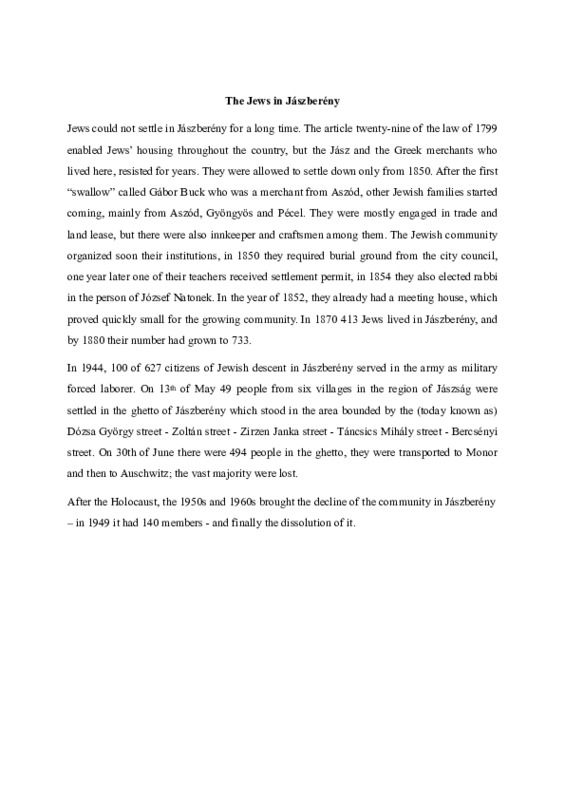PDF Text
Szöveg
The Jews in Jászberény
Jews could not settle in Jászberény for a long time. The article twenty-nine of the law of 1799
enabled Jews’ housing throughout the country, but the Jász and the Greek merchants who
lived here, resisted for years. They were allowed to settle down only from 1850. After the first
“swallow” called Gábor Buck who was a merchant from Aszód, other Jewish families started
coming, mainly from Aszód, Gyöngyös and Pécel. They were mostly engaged in trade and
land lease, but there were also innkeeper and craftsmen among them. The Jewish community
organized soon their institutions, in 1850 they required burial ground from the city council,
one year later one of their teachers received settlement permit, in 1854 they also elected rabbi
in the person of József Natonek. In the year of 1852, they already had a meeting house, which
proved quickly small for the growing community. In 1870 413 Jews lived in Jászberény, and
by 1880 their number had grown to 733.
In 1944, 100 of 627 citizens of Jewish descent in Jászberény served in the army as military
forced laborer. On 13th of May 49 people from six villages in the region of Jászság were
settled in the ghetto of Jászberény which stood in the area bounded by the (today known as)
Dózsa György street - Zoltán street - Zirzen Janka street - Táncsics Mihály street - Bercsényi
street. On 30th of June there were 494 people in the ghetto, they were transported to Monor
and then to Auschwitz; the vast majority were lost.
After the Holocaust, the 1950s and 1960s brought the decline of the community in Jászberény
– in 1949 it had 140 members - and finally the dissolution of it.
The Synagogue
In 1886, Schwarz Herman came up with the idea of building an independent synagogue, for
this purpose the plots of the Jankovich and Beleznay families were purchased on the corner of
the current Dózsa György and Bercsényi street one year later. The plan of the building
-prepared by engineer Károly Kovács -, was selected by a tendering. The construction works
were awarded to the company Ursitz L. and Son. The costs were estimated at 25-26 thousand
forints, the community started collecting, thus Jónás Moskovitz, the president of the
community donated 500, Gábor Buck and Ignác Neuberger 200-200 forints. The City Council
of Jászberény contributed an amount of 1,200 forints along with Albert Apponyi, the Member
of Parliament from Jászberény, who contributed an amount of 50 forints to the construction
costs. The seats of the church were also sold out in advance, the missing amount was provided
by a loan from the People's Bank of Jászkerület.
The construction started in the winter of 1889-1890, due to the loose soil, an extraordinary
foundation was required, so the plans were modified several times.
The synagogue was taken over by the community on 10 September 1890, on that occasion the
Chief Rabbi of Szeged, Immánuel Lőw gave a solemn speech. In addition to city leaders,
representatives of other denominations appeared at the ceremony. The dedicated house of
worship was built in Moorish-style with a long nave interior, the main facade was
symmetrical, with two spherical domes. The capacity of the synagogue could have been about
5-600 people. In 1912, the house of worship had grown by an organ, moreover, a choir was
formed in it. In 1922, a memorial plaque with the list of Jewish victims of World War I was
donated to the Synagogue, in 1947 more memorial plaques, containing the names of the
victims of the Holocaust in Jászberény were placed in the building.
In 1944, 100 of 627 citizens of Jewish descent in Jászberény served in the army as military
forced laborer. On 13th of May 49 people from six villages from the region of Jászság were
settled in the ghetto of Jászberény, which stood in the area bounded by the (today known as)
Dózsa György street - Zoltán street - Zirzen Janka street - Táncsics Mihály street - Bercsényi
street. On 30th of June there were 494 people in the ghetto, which were transported to Monor
and then to Auschwitz; the vast majority were lost.
After the Holocaust, the 1950s and 1960s brought the decline of the community in Jászberény
– in 1949 it had 140 members - and finally, the dissolution of it. The Synagogue had been
increasingly neglected and due to this fact, in 1965 it was sold to the City Council for 325
thousand forints, with the request to use the building for cultural purposes. In 1967, the
memorial plaques were placed in the Jewish cemetery. In 1968 the Synagogue was
demolished, and the building of the city library was erected on its site in 1970. According to
the plans of László Sáros this building was rebuilt in 2005, whose architectural elements
evoke permanently the former synagogue.
Sources:
Bathó Edit: Adatok az első zsidó család életéből. In: Jászsági Évkönyv 1993.
Besenyi Vendel: Emlékezés a holokausztra. In: Szülőföldünk a Jászság. Jász
Múzeumért Alapítvány, Jászberény, 2011.
Csősz László: Jászsági zsidóság a vészkorszakban. In: Jászsági Évkönyv 2006.
Kiss Erika: A jászsági zsidóság emlékeiből. Pro Domine Bt., Jászberény, 2015.
Jews could not settle in Jászberény for a long time. The article twenty-nine of the law of 1799
enabled Jews’ housing throughout the country, but the Jász and the Greek merchants who
lived here, resisted for years. They were allowed to settle down only from 1850. After the first
“swallow” called Gábor Buck who was a merchant from Aszód, other Jewish families started
coming, mainly from Aszód, Gyöngyös and Pécel. They were mostly engaged in trade and
land lease, but there were also innkeeper and craftsmen among them. The Jewish community
organized soon their institutions, in 1850 they required burial ground from the city council,
one year later one of their teachers received settlement permit, in 1854 they also elected rabbi
in the person of József Natonek. In the year of 1852, they already had a meeting house, which
proved quickly small for the growing community. In 1870 413 Jews lived in Jászberény, and
by 1880 their number had grown to 733.
In 1944, 100 of 627 citizens of Jewish descent in Jászberény served in the army as military
forced laborer. On 13th of May 49 people from six villages in the region of Jászság were
settled in the ghetto of Jászberény which stood in the area bounded by the (today known as)
Dózsa György street - Zoltán street - Zirzen Janka street - Táncsics Mihály street - Bercsényi
street. On 30th of June there were 494 people in the ghetto, they were transported to Monor
and then to Auschwitz; the vast majority were lost.
After the Holocaust, the 1950s and 1960s brought the decline of the community in Jászberény
– in 1949 it had 140 members - and finally the dissolution of it.
The Synagogue
In 1886, Schwarz Herman came up with the idea of building an independent synagogue, for
this purpose the plots of the Jankovich and Beleznay families were purchased on the corner of
the current Dózsa György and Bercsényi street one year later. The plan of the building
-prepared by engineer Károly Kovács -, was selected by a tendering. The construction works
were awarded to the company Ursitz L. and Son. The costs were estimated at 25-26 thousand
forints, the community started collecting, thus Jónás Moskovitz, the president of the
community donated 500, Gábor Buck and Ignác Neuberger 200-200 forints. The City Council
of Jászberény contributed an amount of 1,200 forints along with Albert Apponyi, the Member
of Parliament from Jászberény, who contributed an amount of 50 forints to the construction
costs. The seats of the church were also sold out in advance, the missing amount was provided
by a loan from the People's Bank of Jászkerület.
The construction started in the winter of 1889-1890, due to the loose soil, an extraordinary
foundation was required, so the plans were modified several times.
The synagogue was taken over by the community on 10 September 1890, on that occasion the
Chief Rabbi of Szeged, Immánuel Lőw gave a solemn speech. In addition to city leaders,
representatives of other denominations appeared at the ceremony. The dedicated house of
worship was built in Moorish-style with a long nave interior, the main facade was
symmetrical, with two spherical domes. The capacity of the synagogue could have been about
5-600 people. In 1912, the house of worship had grown by an organ, moreover, a choir was
formed in it. In 1922, a memorial plaque with the list of Jewish victims of World War I was
donated to the Synagogue, in 1947 more memorial plaques, containing the names of the
victims of the Holocaust in Jászberény were placed in the building.
In 1944, 100 of 627 citizens of Jewish descent in Jászberény served in the army as military
forced laborer. On 13th of May 49 people from six villages from the region of Jászság were
settled in the ghetto of Jászberény, which stood in the area bounded by the (today known as)
Dózsa György street - Zoltán street - Zirzen Janka street - Táncsics Mihály street - Bercsényi
street. On 30th of June there were 494 people in the ghetto, which were transported to Monor
and then to Auschwitz; the vast majority were lost.
After the Holocaust, the 1950s and 1960s brought the decline of the community in Jászberény
– in 1949 it had 140 members - and finally, the dissolution of it. The Synagogue had been
increasingly neglected and due to this fact, in 1965 it was sold to the City Council for 325
thousand forints, with the request to use the building for cultural purposes. In 1967, the
memorial plaques were placed in the Jewish cemetery. In 1968 the Synagogue was
demolished, and the building of the city library was erected on its site in 1970. According to
the plans of László Sáros this building was rebuilt in 2005, whose architectural elements
evoke permanently the former synagogue.
Sources:
Bathó Edit: Adatok az első zsidó család életéből. In: Jászsági Évkönyv 1993.
Besenyi Vendel: Emlékezés a holokausztra. In: Szülőföldünk a Jászság. Jász
Múzeumért Alapítvány, Jászberény, 2011.
Csősz László: Jászsági zsidóság a vészkorszakban. In: Jászsági Évkönyv 2006.
Kiss Erika: A jászsági zsidóság emlékeiből. Pro Domine Bt., Jászberény, 2015.

